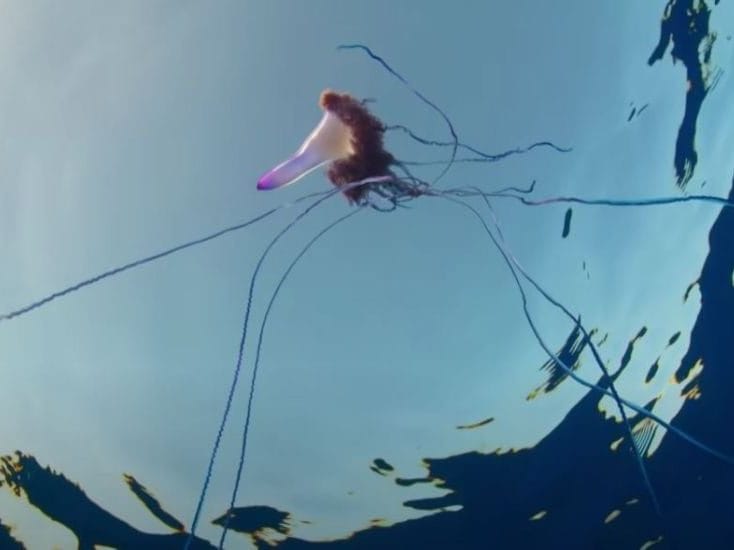These Blue Blobs are The Reason Florida Beaches are Being Shut Down
Spring Break in Florida and South Carolina just got much more dangerous! The arrival of hundreds of deadly Portuguese man O’ war along the popular coastal resorts has left beach-goers on high alert.
With their venomous tentacles lurking in the water, these troublesome visitors are not to be underestimated. Read on to learn more about the Portuguese man O’ war and how to stay safe at the beach.
Unusually large numbers of blue creatures
Indialantic Beach in Brevard County, Florida, has been invaded by a swarm of otherworldly blue creatures – the Portuguese man O’ war! These alien-like creatures have been found in unusually large numbers about 3 miles away from Melbourne Beach.

Source : FOX 13 Tampa Bay / Youtube
While they’re a familiar sight along Florida’s coastline, this sudden influx has left beach-goers scratching their heads. What could be causing this strange phenomenon?
Don't be fooled by its innocent appearance
Hold up, folks – it turns out that the Portuguese man O’ war is not actually a jellyfish! This enigmatic creature is a colony of multiple organisms known as a siphonophore, and it’s causing quite a stir along the coastlines of Florida and beyond.

Source: Rachel Skubel
This small purple or blue balloon may look harmless, but its sting can pack a powerful punch – causing excruciating pain that’s enough to ruin any beach day.
The sting is live and kicking after its death
The Portuguese man O’ war may be dead, but its sting is still alive and kicking! This marine creature, named after an 18th-century Portuguese warship, is notorious for causing painful stings to unsuspecting beachgoers who accidentally step on them after they’ve washed up on the shore.

Source: South Florida 6
Even in death, these dangerous creatures can ruin your day at the beach. Unwary beachgoers who accidentally step on them might find themselves in for a painful surprise.
Tiny capsules are loaded with venom-filled barbed tubes
These creatures belong to a group called siphonophores, colonies of genetically identical clones, each with a specialized function. These colonies are armed with venomous nematocysts, making them a force to be reckoned with.

Source : FOX 13 Tampa Bay / Youtube
These creatures have tentacles loaded with venom-filled barbed tubes, ready to strike at any moment. While some of these colonies can reach up to 6 inches in height, most are only an inch and a half long.
Painful stings that ruin a fun day
If you spot a dazzling jewel-toned blob on the shore, it might be a Portuguese man O’ war! These creatures might not be deadly to humans, but their stings can leave painful welts long after they’ve washed up on the beach.

Source: BBC Earth / Youtube
While they’re known for their deadly tentacles that can take out small fish and crustaceans, their long-lasting sting should have you on high alert.
Mysterious appearance in large numbers
It’s a mysterious sight along Florida’s shores – an unexpected invasion of Portuguese man O’’ war! Nobody’s quite sure why these creatures are suddenly washing up in such large numbers.

Source: Reddit
Experts suspect it might be related to a recent cold front that passed through the region. According to one eyewitness, the churning waves caused by the cold front could be to blame.
A vibrant floating blob of jelly
Picture this: a vibrant, floating blob of jelly that can grow up to six inches long and sits six inches above the waterline. This is the Portuguese man O’ war, and while it might be a sight to behold, you don’t want to get too close!

Source : FOX 13 Tampa Bay / Youtube
These creatures can deliver a painful sting, but according to marine biologist McEwan, it’s not usually deadly unless you have a specific allergy to their toxin.
ManO’war season
Beware of “man-O-war season”! According to Gerry Falconer, a Miami Beach Ocean Rescue member. These dangerous creatures are most commonly found along Florida’s shores between November and March.

Source : FOX 13 Tampa Bay / Youtube
During this time, the winds often blew from the ocean to the land, making it more likely for Portuguese man O’ war to be blown ashore. Keep your eyes peeled during your next beach day, and watch out for these dangerous creatures!
Stay alert on Florida beaches
Don’t be fooled by their stunning appearance, these jellyfish are not to be messed with. Their tentacles are difficult to spot but sting like a live electric shock. Don’t even think about touching them!

Source: Foxweather/ Florida
It’s a triple threat situation with the Red Tide, mutating seaweed, and now these jellyfish on steroids, creating the perfect storm to keep people away. Stay safe and keep your distance from these dangerous sea creatures.
